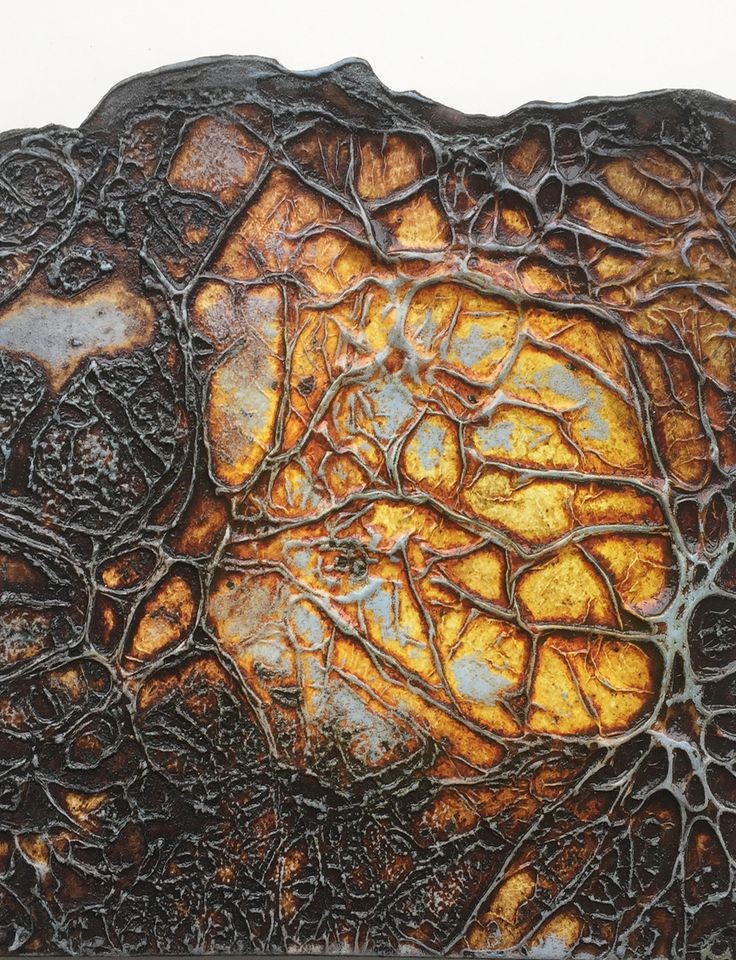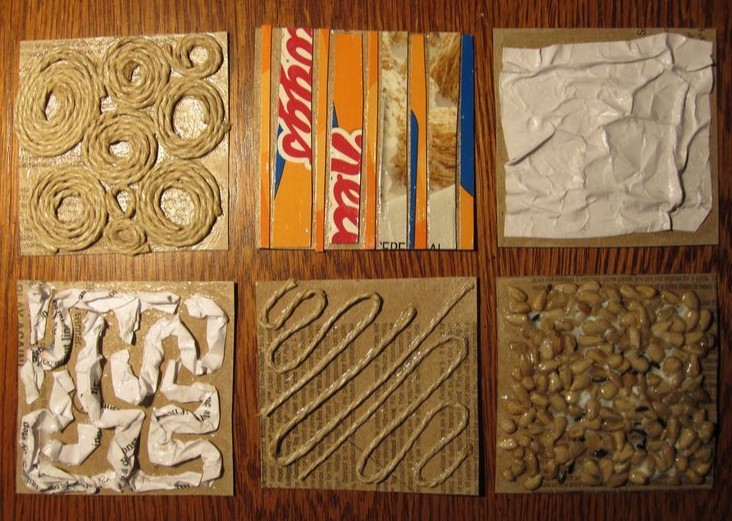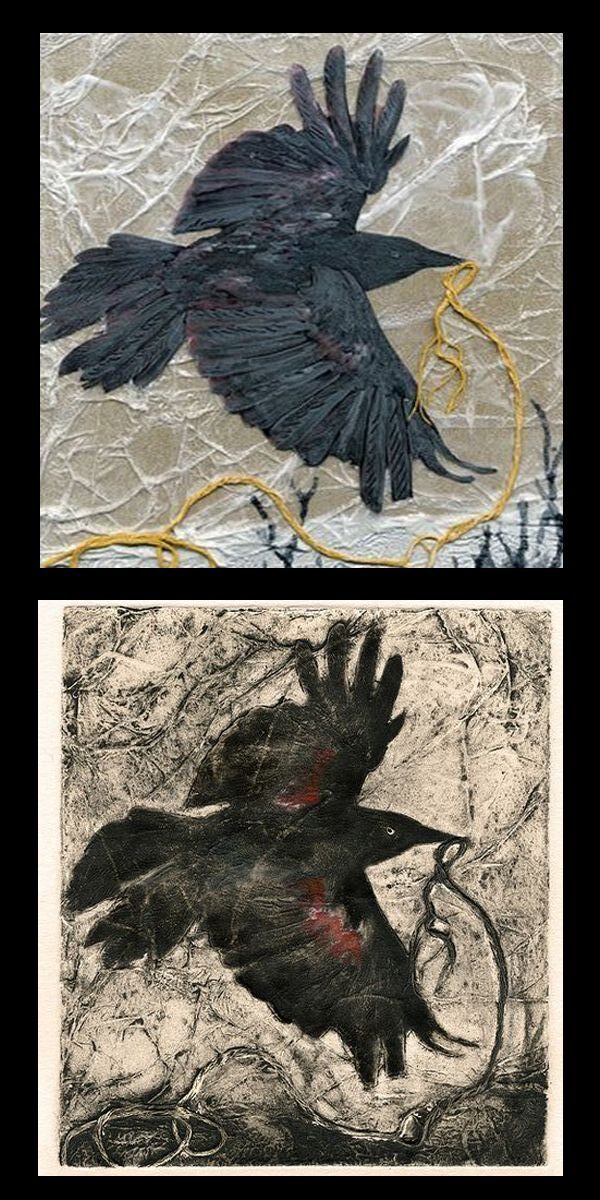
Collagraph Printing.
Collagraph printmaking is a versatile and creative technique in the world of printmaking. It involves creating a printing plate through collage, hence the name “collagraph.” Artists construct the plate by adhering various materials such as paper, fabric, textured surfaces, and found objects onto a rigid substrate like cardboard, wood, or even metal. These materials are arranged to form a composition that will be used for printing.
Once the collage plate is completed, it is sealed and coated with varnish or shellac to protect it and provide a smooth printing surface. Ink is then applied to the surface of the collage plate, filling the recessed areas created by the textures and materials. After inking, the plate is carefully wiped to remove excess ink from the raised areas, leaving ink only in the recessed areas and textures.
The inked collage plate is then placed onto a printing press along with a piece of paper. Pressure is applied to transfer the ink from the collage plate onto the paper, resulting in a printed image. The final print reflects the textures and layers of the original collage, creating unique and visually rich artwork.
Collagraph Printmaking History
Collagraphy has its origins in the 19th century. Historians and artists aren’t sure who invented the process, only that it began decades before getting an official name. Some of the earliest printmakers include Rolf Nesch and Edmond Casarella.
In 1957, artist and teacher Glen Alps coined the name “collagraph” and popularized the genre. Since then, many new printmakers have added to the legacy and concept, creating prints with new materials and for new purposes.
Early Collagraph Prints
The first print likely arose in the late 19th century as artists experimented with various art forms. Lithography, or stone etchings, Japanese woodblock prints, were popular in the latter half of the century. They inspired many artists to experiment with printing methods.
Eventually, an artist attempted to print a base with items pasted on it. Although nobody knows the genre’s exact genesis, artists still debate the nature of Pierre Roche’s 1893 work Algues Marines as the first example. He affixed items to a copper plate, which he then inked and stamped onto Japanese printing paper.
Pre-Alps Collagraph Prints
Collagraphs would stay under the umbrella of prints until Glen Alps made a distinction. Before then, many other artists following Roche made artworks that fit the category.
A Norwegian artist named Rolf Nesch made several metal artworks, including Skaugum, as a series of twenty prints. Nesch experimented with colored intaglio ink during the printing process rather than the typical monochrome early artists used.
Boris Margo is another artist integral to the modern collagraph. In the World War II era, he created the cellocut, an art form that used a plastic plate for printing. This technique pushed artists towards the rigid substrate preference of modern collagraphy. Reconstruction is a famous Margo print that uses his unique method. Finally, Edmond Casarella’s collagraph techniques predated Glen Alps by only a few years. His work Reflections shows the advancement of the genre’s color and texture mastery. Casarella loved to mix inking and impression techniques, treating each part of the piece differently for a varied outcome
Glen Alps and Popularization
In 1956, Glen Alps gave the collagraph genre its name by publishing Collagraph #1. He combined the genres of collage and printmaking to define the textured art form. As a professor, Alps shared the technique with his students to stimulate creativity.
In its time, Glen Alps’ collagraph was cheap to create, using readily available materials like plywood and cardboard. As a way to repurpose and recycle materials, collagraphy grew popular as an upcycling art form. Artists after the Glen Alps created more pieces with the genre’s newfound title. Glen Alps continued to create and publish collagraphs to museums until he died in 1996.
Modern Collagraphs
Following Glen Alps, many modern artists have made their brands with collagraphs. Belkis Ayon brought her Cuban identity to the genre by creating ethereal black-and-white prints depicting mysterious figures. Estella Scholes demonstrated her unique love of coastal textures, by printing the ocean waves on paper.
There are many reputable modern collagraph artists, each with their unique touches. Some create art professionally, while others are hobbyists on Instagram. It is one of the most accessible printing genres due to the ease of material access, and it continues to grow in popularity.


Collagraph Printing Process
The printing process involves several steps:
Creating the Plate
The collagraph process begins by assembling various materials onto a rigid substrate such as cardboard, wood, or Masonite. These materials can include paper, fabric, textured surfaces, strings, plastic or any other found objects. The arrangement of these materials forms the collage plate.
Sealing the Plate
Once the collage is complete, the plate is sealed using a varnish, glue or shellac. This seals the materials in place and provides a smooth surface for inking.
Inking the Plate
Ink is applied to the surface of the collage plate using a brayer or brush. The ink is worked into the textures and recessed areas of the collage, ensuring even coverage.
Wiping the Plate
After inking, the surface of the plate is carefully wiped with a cloth or paper to remove excess ink from the raised areas, leaving ink only in the recessed areas and textures.
Printing the Plate
The inked collage plate is placed onto a printing press, along with a piece of paper. Pressure is applied to the plate and paper using the printing press, transferring the ink from the collage plate onto the paper.
Repeating the Process
Depending on the desired number of prints, the artist may repeat the inking and collagraph printing process multiple times. Each print may vary slightly due to changes in ink application or pressure.
Drying and Finishing
Once printed, the paper is allowed to dry completely. Some artists may choose to further enhance the prints with additional hand-coloring or embellishments.
This collagraph process allows for a high degree of experimentation and creativity, as artists can manipulate the materials and textures in the collage plate to achieve different effects in the final prints.
This printmaking technique offers artists a wide range of possibilities for experimentation and creativity. They can explore different materials, textures, and techniques to create diverse and interesting prints. It’s a process that encourages innovation and artistic expression, making it popular among printmakers.